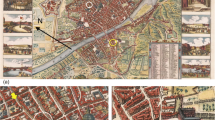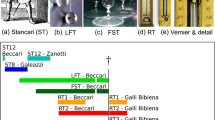Abstract
In 1830, Libri announced the finding of a 16-year-long record of daily temperature observed in Florence, Italy, by Father Renieri before the activity of the Medici Network (1654 to 1670) that is usually considered the earliest instrumental series in the world. The Libri announcement was supported by the concurrent finding of a box with the early Little Florentine Thermometers that survived the Inquisition and was confirmed by Schouw, von Humboldt and Maxwell. However, all investigations made to find Renieri’s observations were fruitless. This paper clarifies this complex situation differentiating between myth and reality. A careful analysis of the Libri’s announcement in the historical context points out that Libri made the announcement while escaping for conspiracy from Florence and needed a scoop to be introduced in the French Academy of Sciences. For this reason he made a deliberate mix of new and old assertions, i.e. he claimed to have made new discoveries but without explaining too much and reporting misleading details about well known stories concerning the earliest meteorological observations. This induced people to suppose that further, earlier records existed. The consequence of this was that climatologists searched for years the claimed records. This paper shows that the Medici Network almost certainly contains the earliest exploitable instrumental observations. The possibility of finding a short series of observations prior to 1654 is remote.




Similar content being viewed by others
References
Accademia della Crusca (1612) Vocabolario degli Accademici della Crusca. Giovanni Alberti, Venice
Alessandra P, Maccioni R, Mostert M (1995) The Life and Times of Guglielmo Libri (1802–1869). Scientist, patriot, scholar, journalist and thief. A nineteenth-century story. Verloren Publishers, Hilversum
Antinori V (1841) Notizie istoriche relative all’Accademia del Cimento. Tipografia Galileiana, Florence
Antinori V (1858) Archivio Meteorologico Centrale Italiano. Società Tipografica sulle Logge del. Grano, Florence
Appleton & Company (1870) American annual encyclopaedia and register of important events, Volume 9, 186. Appleton and Co., New York
Baiada E (1986) Da Beccari a Ranuzzi: la meteorologia nell’Accademia bolognese nel XVIII secolo. In: Finzi R (ed) Le meteore e il frumento. Clima, agricoltura, meteorologia a Bologna nel ’700. Il Mulino, Bologna, pp 99–261
Beretta M (2000) At the source of western science: the organization of experimentalism at the Accademia del Cimento (1657–1667). Notes Rec R Soc London 54(2):131–151
Boffito G (1926) I Benedettini di Vallombrosa nella storia della Meteorologia. Meteorol Prat 6:243–246
Borchi E, Macii R (2009) Meteorologia a Firenze. Nascita ed evoluzione, Pagnini
Camuffo D (2002) History of the long series of the air temperature in Padova (1725-today). Clim Chang 53(1–3):7–76
Camuffo D, Bertolin C (2012a) The earliest temperature observations in the World: the Medici Network (1654–1670). Clim Chang 111:335–363. doi:10.1007/s10584-011-0142-5
Camuffo D, Bertolin C (2012b) A comparison between the earliest period of the Central England Temperature series and the instrumental observations of two Italian stations of the Medici Network, active 1654–1670. Weather 67(8):206–209. doi:10.1002/wea.1913
Camuffo D, Bertolin C (2012c) Recovery of the early period of long instrumental time series of air temperature in Padua, Italy (1716–2007). Phys Chem Earth 40–41:23–31. doi:10.1016/j.pce.2010.02.002
Camuffo D, Bertolin C, Jones P, Cornes R, Garnier E (2010) The earliest daily barometric pressure readings in Italy: Pisa, 1657–8 and Modena, 1694 and the circulation index over Europe, 1694. Holocene 20(3):337–349
Comani S (1987) The historical temperature series of bologna (Italy): 1716–1774. Clim Chang 11:375–390
Cotte L (1774) Traité de Météorologie: contenant 1. l’histoire des observations météorologiques, 2. un traité des météores, 3. l’histoire & la description du baromètre, du thermomètre & des autres instruments météorologiques, 4. les tables des observations météorologiques & botanicométéorologiques, 5. les résultats des tables & des observations, 6. la méthode pour faire les observations météorologiques. Imprimerie Royale, Paris
Del Centina A, Fiocca A (2010) Guglielmo Libri, matematico e storico della matematica. L’irresitibile ascesa dall’Ateneo pisano all’Instituto de France, Olschki, Florence
Fiocca A, Nagliati I (2009) Le cours d’histoire des sciences de Guglielmo Libri au collège de France (1833). Nuncius 24:127–155
Forbes JD (1833) Second Report on Meteorology—1832. In Report of the First and Second Meetings of the British Association for the Advancement of Science. Richard Taylor, London, pp 209–210
Galluzzi P (1957) I saggi di naturali esperienze fatte nell’Accademia del Cimento e strumenti e suppellettili della medesima Accademia conservati presso il Museo di Storia della Scienza di Firenze. Domus Galileiana, IMSS, Florence
Galluzzi P (2001) Scienziati a corte: l’arte della sperimentazione nell’Accademia Galileiana del Cimento: 1657–1667. Sillabe, Livorno
Libri G (1830) Mémoire sur la détermination de l’échelle du thermomètre de l’Académie del Cimento. Ann Chim Phys Paris 45(2):354–361
Libri G (1838–1841) History of Mathematical Sciences in Italy from the Renaissance to the 17th Century. Joule Renouard et C.ie, Paris
Maccioni Ruju PA, Mostert M (1995) The Life and Times of Guglielmo Libri (1802–1869), scientist, patriot, scholar, journalist and thief. A nineteenth- century story. Verloren Publishers, Hilversum
Magalotti L (1667) Saggi di naturali esperienze fatte nell’Accademia del Cimento. Giuseppe Cocchini all'insegna della Stella, Florence
Maracchi G (1991) A brief history of meteorology in Florence from the beginnings to the present. CIESIA-IATA, Florence
Maxwell JC (1871) Postcard to Peter Guthrie Tait. In: Harman PM (ed) The scientific letters and papers of James Clerk Maxwell: 1862–1873. Vol. II. Cambridge University Press, Cambridge, p 648
Maxwell JC (1888) Theory of heat. Longmans Green & Co, London
Maze C (1895a) Sur la plus ancienne série française d’observations thermométriques et météorologiques. C R Acad Sci 120:731–732
Maze C (1895b) Sur la plus ancienne série française d’observations thermométriques et météorologiques. Annu Soc météorol France Paris 43:107–113
Meucci F (1873) Le prime osservazioni meteorologiche; studi sul clima di Firenze nella seconda metà del sec. XVII. Tipografia del Vocabolario, Florence
Middleton WEK (1966) A history of the Thermometer and its use in Meteorology. J. Hopkins Press, Baltimore
Middleton WEK (1971) The Experimenters: A study of the Accademia del Cimento. J. Hopkins Press, Baltimore
Miniati M (1991) In: Catalogo (ed) Museo di Storia della Scienza. Giunti, Florence, 420 pp
Nollet JA (1740–1748) Leçons de physique expérimentale. Guerin, Paris
Redi F (1660) Letters to Carlo Dottori dated 6 December 1660 and 24 November 1660. Printed posthumous in: Opere di Francesco Redi. Stasi, Naples, Tomus VI
Renieri V (1647) Tabulae motuum caelestium. Amadore Massa, Florence
Schouw JF (1839) Tableau du climat de la végétation de l’Italie. Résultat de deux voyages en ce pays dans les années 1817–1819 et 1829–1830, Vol.1. Tableau de la température et des pluies de l’Italie. Librairie Gyldendal, Imprimerie de Bianco Luno, Copenhagen
Targioni Tozzetti G (1780) Notizie degli aggrandimenti delle Scienze Fisiche accaduti in Toscana nel corso di anni LX del secolo XVII, Tomo I. Bouchard, Florence
Vieusseux G (1830) Antologia, Tomo 40, 118:140–143. Luigi Pezzati,Florence
Vittori O, Mestitz A (1981) Calibration of the ‘Little Florentine thermometer’. Endeavour 5(3):113–119
Viviani V (1717 posthumous) Racconto istorico della vita di Galileo. Manuscripts in National Central Library, Florence. Reprinted (1907) in: Favaro A (ed) Opere di Galieo, Barbera, Florence,Vol. 19, pp 597–632
von Humboldt A (1848) Cosmos: Sketch of a Physical description of the Universe, Vol. II. Longman Brown Green and Longmans, London
Acknowledgments
This work was supported by the EU, projects “Climate for Culture” (Grant 226973). This paper was possible thanks to the exquisite cooperation of Colleagues and Institutions who have facilitated the research of scientific and archive data and metadata, or have kindly supplied documents. Special thanks are due to Dr. P. Pirolo and Dr. S. Pelle, National Central Library, Florence; Dr. G. Strano, Dr. A. Lenzi and Dr. S. Cimmino, Museum Galileo - Institute and Museum of History of Science, Florence; Father P.D. Spotorno, Library of Vallombrosa Abbey; Father U. Fossa, Library of Camaldoli Abbey; Prof. E. Borchi and Prof. R. Macii, Ximenian Observatory, Florence.
Author information
Authors and Affiliations
Corresponding author
Rights and permissions
About this article
Cite this article
Camuffo, D., Bertolin, C. The world’s earliest instrumental temperature records, from 1632 to 1648, claimed by G. Libri, are reality or myth?. Climatic Change 119, 647–657 (2013). https://doi.org/10.1007/s10584-013-0742-3
Received:
Accepted:
Published:
Issue Date:
DOI: https://doi.org/10.1007/s10584-013-0742-3




